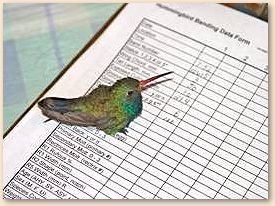 Once the birds are banded and all of the information is
recorded they are given a drink of sugar water and then
they are released. All of the information that we gathered
is transmitted by computer link to the national banding
repository in Patuxent, Maryland.
Once the birds are banded and all of the information is
recorded they are given a drink of sugar water and then
they are released. All of the information that we gathered
is transmitted by computer link to the national banding
repository in Patuxent, Maryland.
I work with the Hummingbird Monitoring Network, a network
of banders that have set up a series of protocols for banding
hummingbirds in a coordinated fashion. Here in southeastern
Arizona we start banding the second week of March, and we
band birds every two weeks until the end of October. We
operate two traps at each station, we open the traps at sunrise
and band for five hours every two weeks. We have cooperating
banders working in New Mexico, Arizona, California, Oregon,
Washington, British Columbia, and Alaska.
Why do we spend endless hours capturing tiny birds, birds that
most people either do not know exists or do not care? We hope
to further our knowledge, but underneath it all there is something
else, something more ephemeral, and something almost spiritual.
When I hold a tiny hummingbird in my hand I am staring into the
eyes of a living creature that is capable of doing things that man,
with all his intellect and God-given genius, is incapable of doing.
Packed within this tiny dynamo of living flesh is the ability to fly
backward, forward, to hover, and even fly upside down. In the
course of its lifetime it will cover distances that boggle my mind.
It will migrate to places it has never been and return again to the
place where I am holding it in my hand without compass, map, or
GPS unit. When I hold this living jewel I am humbled, awed, and
perplexed. Somehow this little bird knows so much more than I
ever will, will experience things that I cannot even imagine, and
will pass from the scene without fanfare or notice. It reminds me
of the limits of human knowledge, and perhaps that is why I rise
up before the sun to chase rainbows.
~ The Chronicler
From A Journal Archives
|



